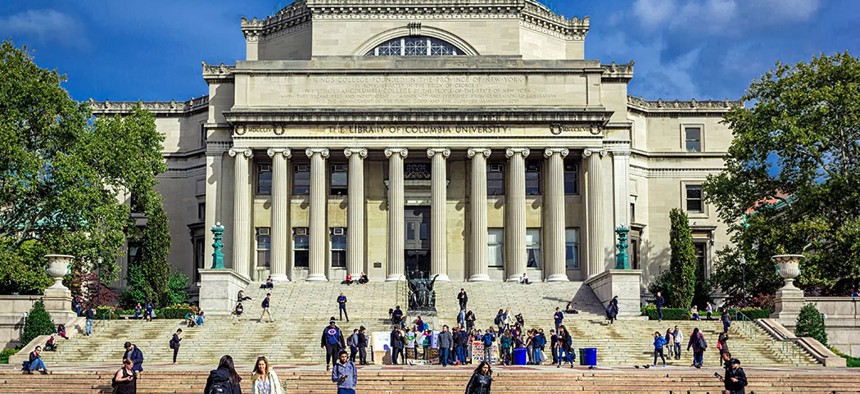New York State
New York should protect students from predatory for-profit colleges
For-profit colleges disproportionately overcharge, underperform and foreclose the futures of far too many students and result in gargantuan loans.

Columbia University library. Dmitrii Sakharov / Shutterstock
For years, for-profit colleges have portrayed themselves as champions of non-traditional, first-generation and low-income students. It’s true that they cater to many of these students, but that doesn’t mean they serve them well. For-profits have mastered the art of selling snake oil, convincing even many lawmakers that these schools give access to higher education to students who otherwise would not.
The truth, however, is that for-profit colleges disproportionately overcharge, underperform and foreclose the futures of far too many students. The problem isn’t isolated to the most egregious for-profit schools, as horrifying as the stories are of sham degrees sold by deceptive recruiters at Corinthian Colleges, worthless credits that employers laugh at from schools like ITT Tech, and sudden closures at schools like Technical Career Institute, Ridley Lowell, and the Art Institute of NYC. It’s a problem endemic to the sector as a whole, including here in New York.
In the Empire State, nearly half of all students (47 percent), and almost three-quarters of black students, who attended for-profit schools defaulted on their student loans within 12 years – nearly fivetimes the rate at nonprofit and public colleges. Only 29 percent of for-profit schools spend at least half of tuition revenue on student instruction, compared to 78 percent of nonprofit schools.
When it comes to student earnings, the outcomes at for-profits are equally dismal. According to the Center for an Urban Future, graduates at 73 percent of for-profit college programs in the state earn less than $25,000 on average, the equivalent of a high-school degree holder between the ages of 25 and 32. What’s more, the for-profit sector accounts for 98 percent of all student fraud claims and 41 percent of student loan defaults, despite enrolling only 6 percent of undergraduate students in New York.
Faced with these realities – many of which were brought to light by courageous students and whistleblowers following the 2015 collapse of Corinthian Colleges – the Obama administration took steps to hold for-profit colleges accountable and protect students. But as important as such policies were, they have not curbed many of the abuses of the for-profit sector, and have done little to improve the value of a for-profit degree.
The risks to students posed by for-profit colleges today have grown, as the Trump administration indulges the industry’s profiteering. At Secretary Betsy DeVos’s direction, the federal Department of Education has sought to dismantle Obama-era protections against for-profit fraud and abuse, and worked to weaken instructional quality standards and repeal debt relief programs for defrauded students.
It’s not just students who pay the price. Taxpayers subsidize all types of colleges, in the form of student aid and scholarship funds to schools. In 2015, New Yorkers delivered $68 million in state tuition aid to for-profit colleges, the highest in the country. More than half of that investment went to programs that failed or nearly failed to meet the federal “gainful employment” requirement – a standard that compares graduates’ debt against their earnings. All 170 career-oriented programs at New York’s CUNY and SUNY schools were evaluated under the same standard and passed.
Fortunately, New York has a chance to respond differently and protect students. Gov. Andrew Cuomo’s proposed “For-Profit Accountability Act” would do just that, by ensuring that for-profit colleges spend at least half of tuition revenue on student instruction and receive no more than 80 percent of their funding from government sources. The proposed legislation also would prohibit for-profit colleges from taking away students’ legal rights by sneaking forced arbitration into enrollment contracts.
Unsurprisingly, New York’s for-profit lobby, which includes the Association of Proprietary Colleges, has reacted by calling attempts to regulate them as an assault on “educational choices.” Why should for-profits be treated any differently than public and nonprofit institutions, they ask. The answer is simple: because they are different.
As leaders of two of our state’s public colleges, we know firsthand the differences in incentives facing for-profit colleges, which exist by definition to generate a profit, and nonprofit private and public colleges, which are already subject to government scrutiny. Our schools’ boards are accountable to the public, not private shareholders, and our leaders must invest students’ tuition dollars and state aid into educational purposes, not pocket that revenue as profit. At for-profit colleges, on the other hand, there are no internal checks on conflicts of interest and no requirements to prioritize the education of students over the returns to shareholders.
As New Yorkers, we should take pride in our national leadership in making college more affordable and accessible. To see the transformative power of higher education, one needs to look no further than the City University of New York system, which in the last three decades has propelled almost six times as many low-income students into the middle class and beyond as all eight Ivy League schools combined.
CUNY schools catalyze social mobility by expanding access to diverse student bodies, providing high-quality educational resources and keeping college costs affordable for students and their families. A similar picture can be painted for the value of our sister institutions in the State University of New York. It cannot be said of many of the for-profit colleges currently operating in the state.
We should no longer accept that. We need to treat education – and an educated citizenry – like the public good it is. That means investing in institutions that truly advance knowledge, equity and social mobility, not those that trick and trap students with mountains of debt and worthless degrees.

NEXT STORY: The Jared Kushner I know